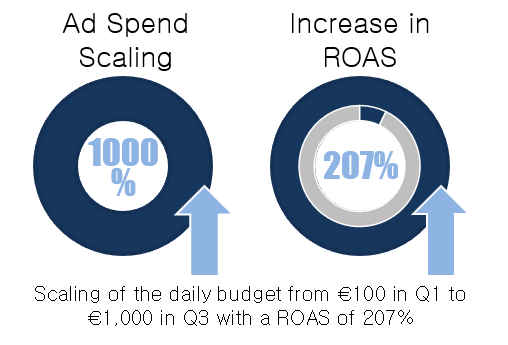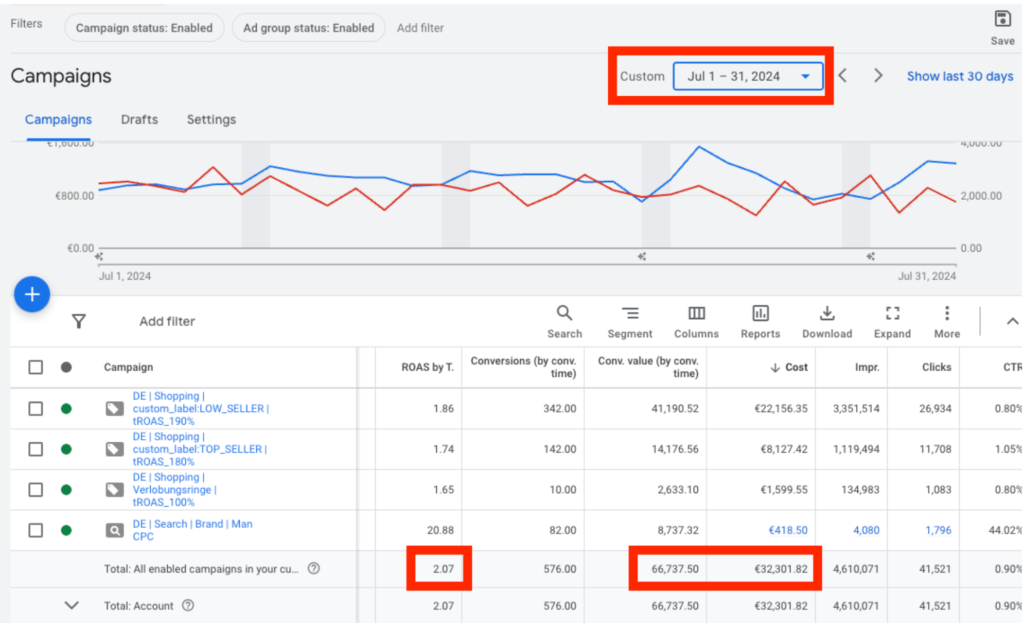E-Commerce
The online store traditionally used Meta and TikTok as its main sales channels and Google Ads only for retargeting and brand awareness. However, within 200 days, we transformed Google Ads from a supporting role to the primary channel for new customer acquisition and significantly increased Velur.de’s sales and profitability.
What have I achieved?
- Scalable non-brand shopping campaigns
Scaled the daily budget from €100 in Q1 to €1,000 in Q3 with a ROAS of 207% - Increased sales and visibility
Better product visibility for new customer purchases through strategic focus on standard Shopping campaigns and optimization of the product feed - Cost-efficient budget management
Exclusion of existing customers and brand search for efficient use of advertising budget for new customers and associated increase in ROI


How did I achieve it?
- Abandoning Performance Max (PMAX)
- We deliberately avoided Google’s PMAX campaigns and instead focused on standard Shopping campaigns to have better control over targeting and spend.
- Implementation of standard Shopping campaigns with tROAS bidding strategies
- Focus on new customer acquisition: Switch to standard Shopping campaigns with a strategic focus on acquiring new customers.
- Exclusion of brand and existing customer target groups: Exclusion of brand and existing customer target groups to ensure that the budget is used to target new potential customers.
- Aggressive tROAS bidding strategies: Implementing tROAS (Target ROAS) bidding strategies with a low/aggressive tROAS target. This allowed Google to bid aggressively for top positions on the Shopping results page, ensuring optimal ad placement and visibility.
- Result: securing top positions in Shopping results, which is critical to capturing high intent traffic and maximizing visibility.
- Optimization of the product feed
- Title optimization: Creating detailed and keyword-rich titles to improve product visibility and relevance.
- Description enhancement: Expanding product descriptions to provide more comprehensive information and include relevant keywords to improve SEO.
- Accurate categorization: Ensuring that each product is correctly categorized within Google’s product taxonomy to improve ad relevance and performance.
- Customized labels: Using custom labels to segment products by performance, seasonality and profit margins. This enabled more precise bid adjustments and budget allocations.
- Target group approach and segmentation
- Detailed target group segmentation: Creation and targeting of specific segments based on demographics, interests and purchasing behavior.
- Split into top products and bestsellers: Segmentation of campaigns into top products and bestsellers to enable targeted advertising measures for the best and best-selling products.
- Split by margin: Split products by profit margin to adjust bids and budget according to profitability.
- Experiment campaigns with higher-priced products: Running experiment campaigns for higher average order value (AOV) products to test and maximize their market potential.
- Conversion tracking and optimization
- Google Ads Conversion Tracking: Setting up comprehensive Google Ads conversion tracking to measure the effectiveness of campaigns, ad groups and keywords.
- Google Tag Manager & Google Ads Pixel: Implementation of conversion tracking via Google Tag Manager and Google Ads Pixel instead of GA4 conversion imports. This enabled more accurate and comprehensive tracking of conversions directly in Google Ads.
- Conversion Rate Optimization (CRO): Using data from conversion tracking to continuously optimize campaigns. Adjustment of bids, keywords and ad copy based on conversion data to maximize ROI.
My conclusion
By abandoning PMAX and strategically utilizing standard Shopping campaigns with aggressive tROAS bidding strategies, we were able to successfully transform Google Ads into a primary channel for new customer acquisition. Detailed product feed optimization, audience segmentation and conversion tracking significantly helped to scale the advertising budget while maintaining a high return on investment. This case study shows that with the right approach, non-brand standard shopping campaigns can be highly scalable and effective for e-commerce companies.












